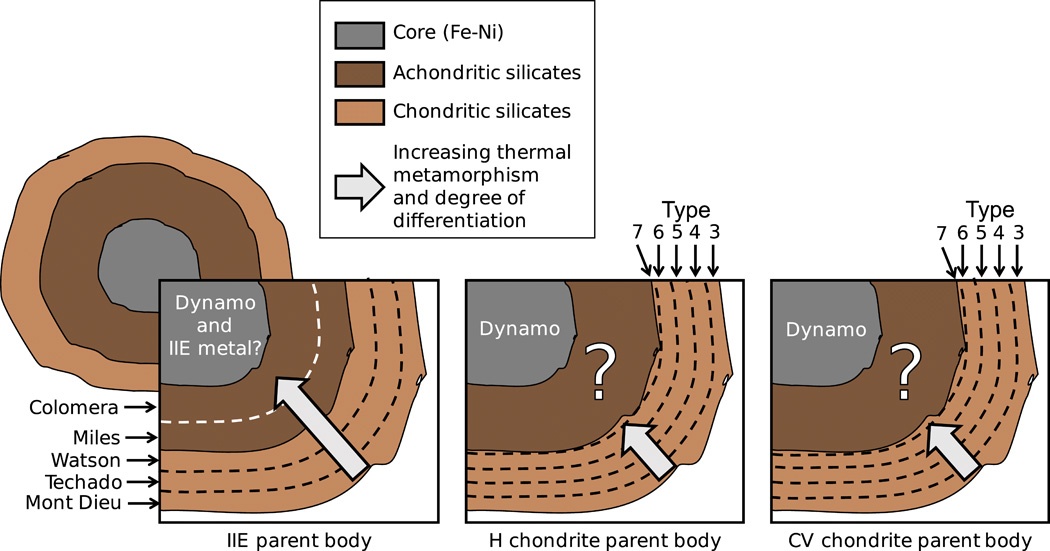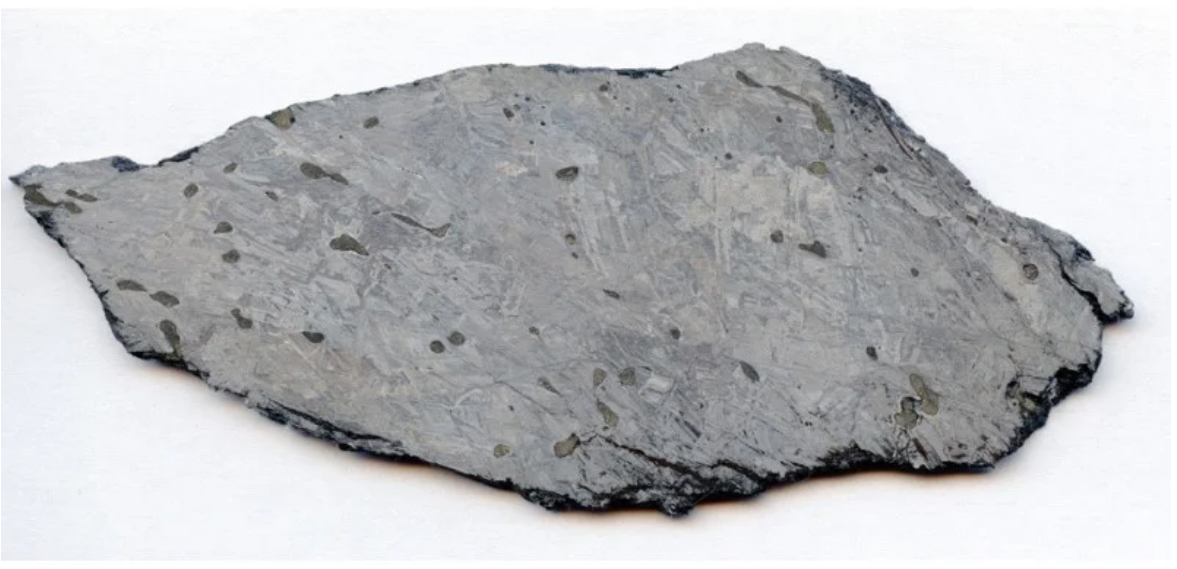Before our Solar System had planets, it had planetesimals. Scientists think that most of the meteorites that have struck Earth are fragments of these planetesimals.
Scientists also think that these planetesimals either melted completely, very early in their history, or that they remained as little more than collections of rocks, or "rubble piles".
But one family of meteorites, that have been found spread around the world, appear to come from a planetesimal that bucked that trend.
New research shows that this one family of meteorites all appear to be from the same parent body. And it provides evidence that the parent body was both melted, and a rubble pile. For scientists, this is a puzzle.
The new study presenting these results is titled "Meteorite evidence for partial differentiation and protracted accretion of planetesimals". The lead author is Clara Maurel, a graduate student in MIT's Department of Earth, Atmospheric, and Planetary Sciences (EAPS). The study is published in the journal Science Advances.
Our system of classifying meteorites assumes that any single parent body can't be the source of both melted (chondritic) and unmelted (achondritic) meteorites. That stems from our understanding of how planetesimals form.
Models show that they form almost instantaneously, which prevents them from being both melted and unmelted. It's long been hypothesized that planetesimals could be differentiated, with both melted and unmelted regions, but evidence has been hard to find.
But this study may have found it. It points out that there may have been more diversity in planetesimals than we think. According to the team of researchers, the parent body of a rare group of meteorites found on Earth must have been differentiated, with both melted and unmelted layers.
It also had a liquid metallic core. And that core produced a powerful magnetic field.
"This is one example of a planetesimal that must have had melted and unmelted layers. It encourages searches for more evidence of composite planetary structures," says lead author Maurel in a press release.
"Understanding the full spectrum of structures, from nonmelted to fully melted, is key to deciphering how planetesimals formed in the early solar system."
This parent body also shows that our understanding of planetesimals, and their formation, is not comprehensive. Some recent proposals suggest that planetesimals may have taken upwards of 1 million years to form, and these results back that up.
In that time frame, according to the authors, "This could have resulted in partially differentiated internal structures, with individual bodies containing iron cores, achondritic silicate mantles, and chondritic crusts."
The key was to find meteorites that are proof of that process, which the authors did. They're called IIE irons.
 IIE meteorites contain evidence for all the layers of a partially differentiated body. (Maurel et al, 2020)
IIE meteorites contain evidence for all the layers of a partially differentiated body. (Maurel et al, 2020)
The tale of these oddball meteorites begins in the early days of the Solar System about 4.5 billion years ago. In the beginning, our system was just a swirling mass of gas and dust.
Over time, of course, it cooled down. And solid matter started to collide and merge, becoming the first planetesimals. These planetesimals are the source of most of the meteorites that strike Earth, and most evidence shows that they came from either melted (chondritic) bodies or unmelted (achondritic).
But whether they were melted or not, researchers think that these planetesimals formed fairly early on. Maybe more importantly, they would've formed quickly, in less than a few million years.
If they formed early enough, they would've contained radiogenic elements that generate heat as they decay to more stable elements. Early in the Solar System's history there were more radiogenic elements, and the heat from all that decay could've melted the entire planetesimal.
Planetesimals that formed later on wouldn't have had less radiogenic material, and wouldn't have melted. That's the nice tidy version of things that's served us well, until now.
Scientists haven't found much evidence of bodies that could be between those two extremes, which they call intermediate planetesimals. These intermediates would have a mixture of melted and unmelted material.
But in this study, the researchers focused on the IIE iron family of meteorites, which the team says is evidence of a differentiated planetesimal with a magnetic core.
 Mont Dieu meteorite from Ardennes France is an IIE iron meteorite. (Meteorites.tv)
Mont Dieu meteorite from Ardennes France is an IIE iron meteorite. (Meteorites.tv)
"These IIE irons are oddball meteorites," said co-author Benjamin Weiss, a professor at EAPS.
"They show both evidence of being from primordial objects that never melted, and also evidence for coming from a body that's completely or at least substantially melted. We haven't known where to put them, and that's what made us zero in on them."
The parent planetesimal of these oddballs was likely differentiated like Earth, with a solid crust and a liquid mantle. But the team of researchers also wondered if it had a metallic core, also like Earth.
"Did this object melt enough that material sank to the center and formed a metallic core like that of the Earth?" Maurel says. "That was the missing piece to the story of these meteorites."
But Earth's molten iron core produces a powerful magnetic field. If the planetesimal had a metallic core, then wouldn't it generate a field too? And wouldn't there be evidence of that inside the meteorites?
When some molten materials solidify in the presence of a magnetic field, they align with the field like the needle of a compass. Some minerals retain that evidence for billions of years.
To find out, the team found samples of IIE iron meteorites and tested them at the Lawrence Berkeley National Laboratory. They used the lab's Advanced Light Source (ALS), which produces x-rays that interact with mineral grains.
They were looking for a mineral made of iron and nickel that interacts in a certain way with the x-rays. That interaction, on the nanometer scale, can reveal the magnetic orientation of the minerals.
The team found what they suspected: electrons in some mineral grains were aligned magnetically. That's evidence that they cooled in a magnetic field. The researchers also found that the planetesimal's magnetic field may have been as strong as Earth's.
After more analysis, the researchers concluded that the magnetic field had the same source as Earth's: a liquid metal core. They were also able to calculate the size of that metallic core. According to the team, the core was likely several tens of kilometers wide.
These complex, mixed planetesimals, with both molten and solid components, would've taken a longer time to form. Several million years, according to lead author Maurel. And that's much longer than existing models show.
The team of researchers had another question: where in the parent body were these meteorites from?
They couldn't be from the liquid metallic core that generated the magnetic field. That's because the meteorites, obviously, were solidified in the presence of a the magnetic field, and the core only produces the field while in a liquid state. Meteorites must have come from somewhere outside the core, where the rock solidified in the presence of the liquid core's magnetic field.
After more work, including running high velocity simulations of different formation scenarios for the meteorites, they had a possible answer.
Their simulations showed that if a parent body with a molten core collided with another object, it's possible that material could be dislodged from the core. That material could end up closer to the surface, where the meteorites came from.
 (Maurel et al, 2020)
(Maurel et al, 2020)
IMAGE: This graphic from the study shows results from one of the impact scenarios. It shows a differentiated planetesimal with a 170 km radius, including a 60 km radius iron core, and a 110 km radius outer layer. On the left half of each panel is the body's constituent materials, and on the right half of each is the temperature. At the end of the material, small amounts of the core are placed in the upper half of the outer layer
"As the body cools, the meteorites in these pockets will imprint this magnetic field in their minerals. At some point, the magnetic field will decay, but the imprint will remain," Maurel says.
"Later on, this body is going to undergo a lot of other collisions until the ultimate collisions that will place these meteorites on Earth's trajectory."
What a long, torturous history for a piece of rock.
The final question in all of this is: how common are these differentiated planetesimals? Was this an outlier, or are there many more of them?
That answer is out of reach, for now. But whatever the answer is, we'll probably find it in the asteroid belt, home to legions of primordial, rocky objects.
"Most bodies in the asteroid belt appear unmelted on their surface," Weiss says. "If we're eventually able to see inside asteroids, we might test this idea. Maybe some asteroids are melted inside, and bodies like this planetesimal are actually common."
This article was originally published by Universe Today. Read the original article.
#Space | https://sciencespies.com/space/strange-meteorites-found-across-earth-revealed-as-fragments-of-the-same-baby-planet/
No comments:
Post a Comment